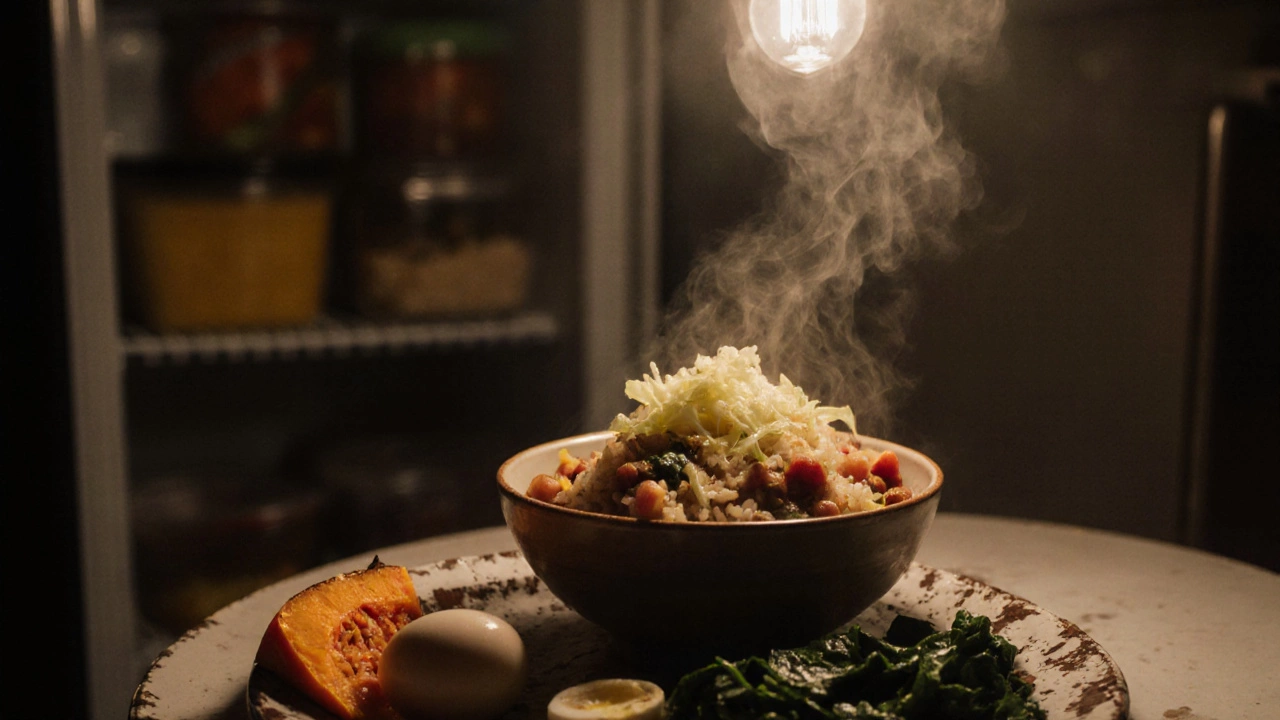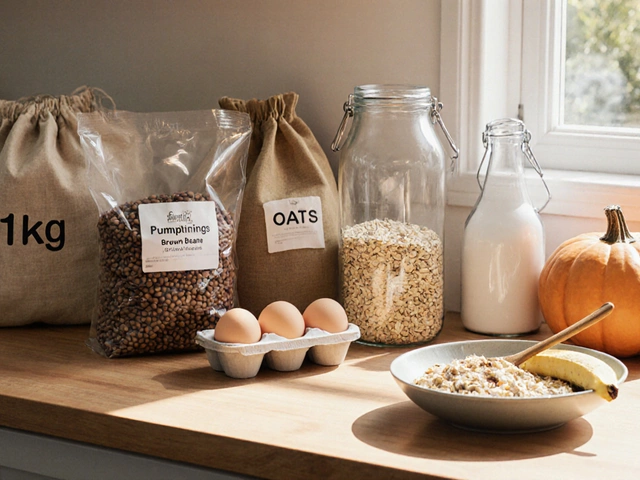Weekly Meal Cost Calculator
Calculate Your Weekly Food Budget
Based on the article's $20/week healthy meal strategy using affordable staples like beans, rice, and eggs.
Pro Tip This tool uses prices from the article: 1kg beans ($3.50), 2kg rice ($4.50), 12 eggs ($4.20)
Estimated Daily Protein:
60-80g/day achievable with beans, eggs, and chicken
Your Budget Results
Living on under $20 a week for food sounds impossible-until you actually try it. I’ve done it. Not because I had to, but because I wanted to prove it could be done without giving up real food. No instant noodles for seven days. No skipping meals. Just smart choices, plain ingredients, and a little planning. And yes, it’s still possible in Wellington in 2025, even with rising prices.
Start with what’s cheap and fills you up
Not all food is created equal when it comes to cost per calorie or cost per gram of protein. The cheapest, most filling foods are also the most nutritious if you know where to look. Beans, rice, oats, potatoes, eggs, and seasonal vegetables are your best friends.
Look at the numbers: a 1kg bag of dried brown beans costs about $3.50 at Pak’nSave. That’s 10 servings. Each serving gives you 15g of protein and 12g of fiber. A 2kg bag of rice? Around $4.50. That’s 20 servings. One egg? About 35 cents. You can get a dozen for $4.20 at the local market on Tuesday mornings.
These aren’t just cheap-they’re powerful. A bowl of oats with a spoon of peanut butter and a banana costs less than $1.50 and keeps you full until lunch. A plate of rice and beans with sautéed cabbage? Under $1.20. You’re not eating scraps. You’re eating real, nutrient-dense food that your body actually needs.
Buy in bulk, but only the right things
Bulk buying saves money-but only if you buy things you’ll actually use. Don’t buy a 10kg bag of quinoa because it’s trendy. Buy dry beans, rice, oats, lentils, and pasta. These last for months. They don’t spoil. They don’t need refrigeration.
At the Asian supermarket on Karori Road, you can get 2kg of dried lentils for $3.80. That’s 40 servings. At the bulk bins in New World, you can scoop your own rice for $1.80 per kg-half the price of pre-packaged. Bring your own cloth bags. No extra cost. No waste.
Also, skip the pre-cut veggies. A whole cabbage costs $1.50. You can get 5 meals out of it. Cut it yourself. Store the rest in the fridge. A whole pumpkin? $2.50. Roast it. Scoop out the seeds and roast them too. You’ll get soup, mash, and snacks from one pumpkin.
Plan meals around one protein source per week
Meat is expensive. Chicken breast? $14 a kg. That’s $1.40 per serving. If you eat meat every day, you’re already halfway to your $20 budget before you even touch vegetables.
Instead, pick one protein day per week. Buy a whole chicken for $12. Roast it. Eat the meat for two meals. Use the bones to make broth for soup. You’ve just stretched $12 into 5 meals. Add lentils or beans to the other days. You’re still getting 50-60g of protein daily without touching expensive cuts.
Or go plant-based for five days. A can of chickpeas is $1.20. Mash them with cumin, garlic, and lemon. Make falafel patties. Freeze half. You’ve got two meals for $1.20. Add rice and spinach. Done.
Use the freezer like a weapon
The freezer isn’t just for ice cubes. It’s your secret weapon against waste and impulse buys.
Buy a big bag of frozen spinach for $3. It lasts 6 months. Add it to soups, eggs, rice dishes. Frozen peas? $2.50. Frozen broccoli? $2.80. These are often cheaper and just as nutritious as fresh. They’re picked at peak ripeness and flash-frozen.
Leftovers? Freeze them. Cook a big pot of bean stew on Sunday. Portion it into jars. You’ve got 4 lunches ready. No cooking on busy days. No takeout.
And if you find a deal on eggs? Buy two dozen. Crack them into a container, whisk, freeze in portions. You can use them later for scrambles, frittatas, or baking. No waste. No stress.

Shop at the right time, in the right places
Supermarkets mark things down at specific times. Know them.
Pak’nSave: Meat and dairy get discounted at 6pm. Go right before closing. You’ll find chicken thighs for $6/kg, yogurt for 50c, even fresh bread for $1.50. It’s not expired-it’s just nearing its best-before date. Safe to eat. Just freeze or cook it the same day.
Farmer’s markets on Saturday afternoon? Vendors slash prices to clear stock. A bunch of carrots? 50c. A bag of apples? $1.50. A whole cauliflower? $1. You’re not getting the perfect-looking produce. You’re getting the food that still tastes amazing.
Check the ‘imperfect produce’ boxes at New World. $4 for a box of misshapen carrots, onions, potatoes, and capsicums. You can’t sell them for display, but they’re perfectly fine to cook with. That’s 5-6 meals for $4.
Water, tea, and homemade snacks
Drinks and snacks are where budgets explode. Bottled water? $2 a bottle. Juice? $4 a carton. Chips? $3 a bag. That’s your whole weekly budget gone in three items.
Drink tap water. It’s safe in Wellington. Use a reusable bottle. Boil water for tea. Buy loose-leaf tea in bulk-$8 for 200g. That’s 100 cups. Or make your own herbal tea from dried mint or lemon balm from your windowsill.
Snacks? Roast chickpeas with paprika. Make popcorn on the stove with a little oil. Slice an apple and sprinkle it with cinnamon. A banana costs 30c. You don’t need granola bars or protein snacks. Real food works better.
A sample $18.70 weekly plan
Here’s what a real week looks like on $20:
- 1kg dried beans ($3.50)
- 2kg rice ($4.50)
- 12 eggs ($4.20)
- 1kg oats ($2.50)
- 1 whole chicken ($12) - but this is split across two weeks, so $6 this week
- 1 cabbage ($1.50)
- 1 pumpkin ($2.50)
- 1kg frozen spinach ($3)
- 1 bunch of carrots ($1)
- 1 banana ($0.30)
Total: $18.70
Meals:
- Breakfast: Oats with banana and a boiled egg
- Lunch: Rice and bean stew with cabbage
- Dinner: Roasted chicken with pumpkin mash
- Snack: Roasted chickpeas or carrot sticks
- Leftovers: Soup made from chicken bones and frozen spinach
You’re not hungry. You’re not eating junk. You’re eating food that gives you energy, keeps your digestion regular, and doesn’t cost a fortune.
What you’ll actually notice
After a few weeks, you’ll stop craving expensive stuff. You’ll realize you didn’t miss it. Your taste buds adjust. You start noticing how good plain food tastes. You save money. You waste less. You feel more in control.
And here’s the quiet win: you’re not just eating cheap. You’re eating better than most people who think they’re eating healthy because they buy kale smoothies for $12.

Common mistakes to avoid
- Buying pre-packaged ‘healthy’ snacks-they’re usually more expensive and less nutritious
- Shopping when you’re hungry-you’ll buy things you don’t need
- Ignoring expiration dates on discounted items-most are safe if used quickly
- Thinking you need supplements-you don’t. Real food gives you everything
- Buying spices in tiny packets-buy them in bulk or skip them. Salt, pepper, garlic powder, and paprika are enough
What if you need more protein?
Need more? Add another dozen eggs. Or buy a second can of lentils. You’re not locked into $20. That’s a starting point. If you get paid weekly, you can adjust. But even at $20, you’re getting 60-80g of protein a day from beans, eggs, chicken, and rice. That’s more than enough for most people.
What if you’re on a tight schedule?
You don’t need to cook from scratch every day. Batch cook on Sunday. Make a big pot of beans and rice. Roast a whole pumpkin. Hard-boil a dozen eggs. Portion it out. Reheat. Done. Five minutes in the microwave. No takeout. No stress.
Can you do this long-term?
Yes. People have done this for generations. Before supermarkets, before processed food, people ate this way. It’s not a trend. It’s a return to what worked.
It’s not about deprivation. It’s about choosing what matters. Food that nourishes. Food that lasts. Food that doesn’t drain your wallet.
You don’t need to be perfect. Miss a day? Eat rice and beans again tomorrow. The goal isn’t to be a hero. It’s to prove you can live well without spending like a tourist.







